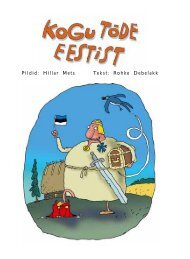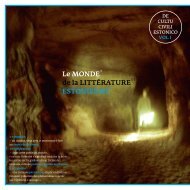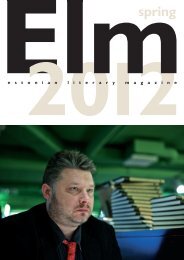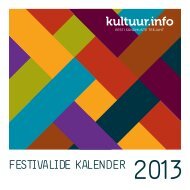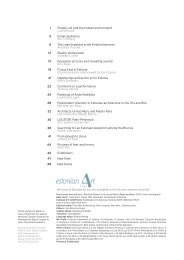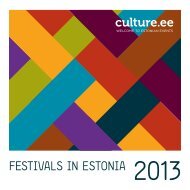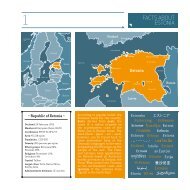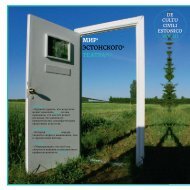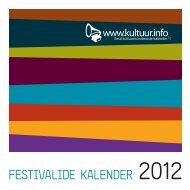Autumn 2013
Autumn 2013
Autumn 2013
Create successful ePaper yourself
Turn your PDF publications into a flip-book with our unique Google optimized e-Paper software.
Rein Raud<br />
Rekonstruktsioon<br />
(The Reconstruction)<br />
Tallinn, Mustvalge Kirjastus, 2012. 264 pp<br />
ISBN: 9789949927715<br />
Rein Raud (Photo by Scanpix)<br />
medieval Tallinn. After publishing the<br />
third book, Hargla received the annual<br />
award of the Estonian Cultural Endowment<br />
in 2011 for this series of historical<br />
crime novels, for his continuing high<br />
standard of creative work and for his<br />
genre diversity.<br />
Apothecary Melchior and the<br />
Strangler of Pirita is the long-awaited<br />
fourth book of the Melchior series, and it<br />
is as fascinating as all the previous books<br />
featuring Melchior. With well-developed<br />
characters and skillful building of tension,<br />
Hargla keeps his readers reading late<br />
into the night. His detailed depiction of<br />
the medieval environment carries readers<br />
back to the beginning of the 15th century.<br />
This time Melchior is asked to come to<br />
the Pirita convent and join an extraordinarily<br />
convened council of wise men.<br />
On his way to the convent, Melchior finds<br />
a dead body in a snowdrift. As it turns<br />
out, the first victim of the strangler of<br />
Pirita is not the last one. After finding the<br />
next victim, Melchior swears to Abbess<br />
Kandis, in the name of Saint Birgitta, that<br />
he will reveal the murderer and solve<br />
these crimes. This investigation leads<br />
Melchior to astounding secrets about the<br />
distant past. At the same time, difficulties<br />
arise at home in Tallinn. MI<br />
This is a story about seeking security and<br />
longing for certainty, a story about searching<br />
for truth and universal answers, about<br />
searching but not finding. Having doubts,<br />
while also yearning for absolute truth, can<br />
lead us to estrangement from reality. It<br />
slowly cuts us off from our everyday life and<br />
from the people who love us. Where does<br />
dedication end and obsession begin?<br />
Five years after losing his daughter Anni,<br />
Enn Padrik finds out that he has cancer. As<br />
he doesn’t have much time left in this world,<br />
he decides to finally do something he should<br />
have done a long ago. Finding out the whole<br />
story behind his daughter’s suicide becomes<br />
Enn’s last mission. All he knows is that it was<br />
a collective suicide in a community of<br />
intellectuals, probably committed for<br />
religious reasons. He travels around Estonia<br />
and even goes to France to meet people<br />
who had known Anni. The process of<br />
patching different memories and stories into<br />
one whole turns out to be more complicated<br />
than Enn thought. But little by little the start<br />
starts to emerge. At the end of his quest,<br />
Enn comes to understand that it doesn’t<br />
matter whether what we believe in is actually<br />
true or not. What matters is how these<br />
beliefs change us, and what kind of people<br />
we become by believing what we believe.<br />
The story is very thought-provoking but,<br />
despite the heaviness of the theme, it’s not<br />
moralizing or otherwise patronizing to its<br />
readers. It’s a deeply psychological novel,<br />
written in a gripping way. Realistic and<br />
accurately described characters make the<br />
story plausible, even though problems with<br />
religious sects are not common in Estonian<br />
society.<br />
Rein Raud (b. 1961) received the literary<br />
prose award of the Estonian Cultural



